Self-Regenerating Solar Evaporation System for Simultaneous Salt Collection and Freshwater from Seawater
Abstract
:1. Introduction
2. Materials and Methods
2.1. Synthesis of Honokiol Biochar (HB)
2.2. HB-Printed Fabric
2.3. Results & Discussion
| Sr No. | Material | Absorption | Evaporation Rate | Photothermal Conversion Efficiency | Ref. |
|---|---|---|---|---|---|
| 1. | Ti2O3 | 90% | 1.32 | 92% | [34] |
| 2. | Fe2O3/CNT | 97% | 1.42 | 87.2% | [35] |
| 3. | Silk/rGO | 94% | 1.48 | 102% | [36] |
| 4. | Polymer foams | 94% | 1.54 | 90.4% | [37] |
| 5. | MnO2/rGO Aerogel | 100 | 1.35 | 93.8% | [38] |
| 6. | HN/NiO | 92.1 | 1.37 | 85.8% | [39] |
| 7. | Graphene membrane | 99.9 | 1.37 | 90% | [40] |
| 8. | CuS/Sn2S3 | 92% | 1.42 | 82.9% | [41] |
| 9. | CuS/agaros | 94% | 1.63 | 94.9% | [42] |
| 10. | HB@NF | 96% | 1.64 | 93% | This work |
3. Conclusions
Supplementary Materials
Author Contributions
Funding
Data Availability Statement
Conflicts of Interest
Abbreviations
| Sr. No. | Name | Abbreviation |
| 1. | Honokiol | HK |
| 2. | honokiol biochar | HB |
| 3. | non-woven fabric | NF |
| 4. | Negative Emission Technologies | NET |
| 5. | Polystyrene foam | (PSF) |
| 6. | World Health Organization | (WHO) |
| 7. | Inductively Coupled Plasma-Optical Emission Spectrometry | (ICP-OES) |
| 8. | Sodium Chloride | NaCl |
| 9. | Infrared | (IR) |
| 10. | X-ray photoelectron spectroscopy | (XPS) |
| 11. | Fourier transform infrared spectroscopy | (FTIR). |
| 12. | 1 sun | 1 kW m−2 |
References
- Seckler, D.; Barker, R.; Amarasinghe, U. Water Scarcity in the Twenty-First Century. Int. J. Water Resour. Dev. 1999, 15, 29–42. [Google Scholar] [CrossRef]
- Mekonnen, M.M.; Hoekstra, A.Y. Four Billion People Facing Severe Water Scarcity. Sci. Adv. 2016, 2, e1500323. [Google Scholar] [CrossRef] [PubMed]
- Khawaji, A.D.; Kutubkhanah, I.K.; Wie, J.-M. Advances in Seawater Desalination Technologies. Desalination 2008, 221, 47–69. [Google Scholar] [CrossRef]
- Ahmed, F.E.; Hashaikeh, R.; Hilal, N. Solar Powered Desalination—Technology, Energy and Future Outlook. Desalination 2019, 453, 54–76. [Google Scholar] [CrossRef]
- Li, C.; Goswami, Y.; Stefanakos, E. Solar Assisted Sea Water Desalination: A Review. Renew. Sustain. Energy Rev. 2013, 19, 136–163. [Google Scholar] [CrossRef]
- Wang, S.; Liu, Y.; Yang, A.; Zhu, Q.; Sun, H.; Sun, P.; Yao, B.; Zang, Y.; Du, X.; Dong, L. Xanthate-Modified Magnetic Fe3O4@SiO2-Based Polyvinyl Alcohol/Chitosan Composite Material for Efficient Removal of Heavy Metal Ions from Water. Polymers 2022, 14, 1107. [Google Scholar] [CrossRef]
- Irshad, M.S.; Wang, X.; Abbasi, M.S.; Arshad, N.; Chen, Z.; Guo, Z.; Yu, L.; Qian, J.; You, J.; Mei, T. Semiconductive, Flexible MnO2 NWs/Chitosan Hydrogels for Efficient Solar Steam Generation. ACS Sustain. Chem. Eng. 2021, 9, 3887–3900. [Google Scholar] [CrossRef]
- Irshad, M.S.; Wang, X.; Abbas, A.; Yu, F.; Li, J.; Wang, J.; Mei, T.; Qian, J.; Wu, S.; Javed, M.Q. Salt-Resistant Carbon Dots Modified Solar Steam System Enhanced by Chemical Advection. Carbon 2021, 176, 313–326. [Google Scholar] [CrossRef]
- Yang, Z.; Li, D.; Yang, K.; Chen, L.; Wang, J.; Zhu, X.; Chen, B. Optimized Water Supply in a Solar Evaporator for Simultaneous Freshwater Production and Salt Recycle. Environ. Sci. Technol. 2023, 57, 13047–13055. [Google Scholar] [CrossRef]
- Zhao, W.; Gong, H.; Song, Y.; Li, B.; Xu, N.; Min, X.; Liu, G.; Zhu, B.; Zhou, L.; Zhang, X.-X.; et al. Hierarchically Designed Salt-Resistant Solar Evaporator Based on Donnan Effect for Stable and High-Performance Brine Treatment. Adv. Funct. Mater. 2021, 31, 2100025. [Google Scholar] [CrossRef]
- Chen, C.; Zhou, L.; Yu, J.; Wang, Y.; Nie, S.; Zhu, S.; Zhu, J. Dual Functional Asymmetric Plasmonic Structures for Solar Water Purification and Pollution Detection. Nano Energy 2018, 51, 451–456. [Google Scholar] [CrossRef]
- Irshad, M.S.; Arshad, N.; Zhang, J.; Song, C.; Mushtaq, N.; Alomar, M.; Shamim, T.; Dao, V.-D.; Wang, H.; Wang, X.; et al. Wormlike Perovskite Oxide Coupled with Phase-Change Material for All-Weather Solar Evaporation and Thermal Storage Applications. Adv. Energy Sustain. Res. 2023, 4, 2200158. [Google Scholar] [CrossRef]
- Irshad, M.S.; Wang, X.; Arshad, N.; Javed, M.Q.; Shamim, T.; Guo, Z.; Li, H.R.; Wang, J.; Mei, T. Bifunctional In-Situ Polymerized Nanocomposites for Convective Solar Desalination and Enhanced Photo-Thermoelectric Power Generation. Environ. Sci. Nano 2022, 9, 1685–1698. [Google Scholar] [CrossRef]
- Wang, J.; Shamim, T.; Arshad, N.; Irshad, M.S.; Mushtaq, M.N.; Zhang, C.; Yousaf, M.; Alshahrani, L.A.; Akbar, M.; Lu, Y. In Situ Polymerized Fe2O3@ PPy/Chitosan Hydrogels as a Hydratable Skeleton for Solar-Driven Evaporation. J. Am. Ceram. Soc. 2022, 105, 5325–5335. [Google Scholar] [CrossRef]
- Fuzil, N.S.; Othman, N.H.; Alias, N.H.; Marpani, F.; Othman, M.H.D.; Ismail, A.F.; Lau, W.J.; Li, K.; Kusworo, T.D.; Ichinose, I.; et al. A Review on Photothermal Material and Its Usage in the Development of Photothermal Membrane for Sustainable Clean Water Production. Desalination 2021, 517, 115259. [Google Scholar] [CrossRef]
- Lin, Y.; Xu, H.; Shan, X.; Di, Y.; Zhao, A.; Hu, Y.; Gan, Z. Solar Steam Generation Based on the Photothermal Effect: From Designs to Applications, and Beyond. J. Mater. Chem. A 2019, 7, 19203–19227. [Google Scholar] [CrossRef]
- Tan, K.W.; Yap, C.M.; Zheng, Z.; Haw, C.Y.; Khiew, P.S.; Chiu, W.S. State-of-the-Art Advances, Development, and Challenges of Metal Oxide Semiconductor Nanomaterials for Photothermal Solar Steam Generation. Adv. Sustain. Syst. 2022, 6, 2100416. [Google Scholar] [CrossRef]
- Dao, V.-D.; Vu, N.H.; Yun, S. Recent Advances and Challenges for Solar-Driven Water Evaporation System toward Applications. Nano Energy 2020, 68, 104324. [Google Scholar] [CrossRef]
- Ding, T.; Zhou, Y.; Ong, W.L.; Ho, G.W. Hybrid Solar-Driven Interfacial Evaporation Systems: Beyond Water Production towards High Solar Energy Utilization. Mater. Today 2021, 42, 178–191. [Google Scholar] [CrossRef]
- Irshad, M.S.; Arshad, N.; Liu, G.; Mushtaq, N.; Lashari, A.A.; Qin, W.; Asghar, M.S.; Li, H.; Wang, X. Biomass-Printed Hybrid Solar Evaporator Derived from Bio-Polluted Invasive Species, a Potential Step toward Carbon Neutrality. ACS Appl. Mater. Interfaces 2023, 15, 16607–16620. [Google Scholar] [CrossRef]
- Yu, F.; Guo, Z.; Xu, Y.; Chen, Z.; Irshad, M.S.; Qian, J.; Mei, T.; Wang, X. Biomass-Derived Bilayer Solar Evaporator with Enhanced Energy Utilization for High-Efficiency Water Generation. ACS Appl. Mater. Interfaces 2020, 12, 57155–57164. [Google Scholar] [CrossRef] [PubMed]
- Lonappan, L.; Rouissi, T.; Das, R.K.; Brar, S.K.; Ramirez, A.A.; Verma, M.; Surampalli, R.Y.; Valero, J.R. Adsorption of Methylene Blue on Biochar Microparticles Derived from Different Waste Materials. Waste Manag. 2016, 49, 537–544. [Google Scholar] [CrossRef]
- Munroe, M.E.; Arbiser, J.L.; Bishop, G.A. Honokiol, a Natural Plant Product, Inhibits Inflammatory Signals and Alleviates Inflammatory Arthritis. J. Immunol. 2007, 179, 753–763. [Google Scholar] [CrossRef] [PubMed]
- Shen, J.-L.; Man, K.-M.; Huang, P.-H.; Chen, W.-C.; Chen, D.-C.; Cheng, Y.-W.; Liu, P.-L.; Chou, M.-C.; Chen, Y.-H. Honokiol and Magnolol as Multifunctional Antioxidative Molecules for Dermatologic Disorders. Molecules 2010, 15, 6452–6465. [Google Scholar] [CrossRef] [PubMed]
- Crane, C.; Panner, A.; Pieper, R.O.; Arbiser, J.; Parsa, A.T. Honokiol Mediated Inhibition of PI3K/MTOR Pathway: A Potential Strategy to Overcome Immunoresistance in Glioma, Breast and Prostate Carcinoma without Impacting T Cell Function. J. Immunother. 2009, 32, 585. [Google Scholar] [CrossRef] [PubMed]
- Jiang, Y.; An, N.; Sun, Q.; Guo, B.; Wang, Z.; Zhou, W.; Gao, B.; Li, Q. Biomass Hydrogels Combined with Carbon Nanotubes for Water Purification via Efficient and Continuous Solar-Driven Steam Generation. Sci. Total Environ. 2022, 837, 155757. [Google Scholar] [CrossRef]
- Yang, L.; Li, N.; Guo, C.; He, J.; Wang, S.; Qiao, L.; Li, F.; Yu, L.; Wang, M.; Xu, X. Marine Biomass-Derived Composite Aerogels for Efficient and Durable Solar-Driven Interfacial Evaporation and Desalination. Chem. Eng. J. 2020, 417, 128051. [Google Scholar] [CrossRef]
- Chen, X.; Wu, Z.; Lai, D.; Zheng, M.; Xu, L.; Huo, J.; Chen, Z.; Yuan, B.; Fu, M.-L. Resilient Biomass-Derived Hydrogel with Tailored Topography for Highly Efficient and Long-Term Solar Evaporation of High-Salinity Brine. J. Mater. Chem. A 2020, 8, 22645–22656. [Google Scholar] [CrossRef]
- Lin, X.; Wang, P.; Hong, R.; Zhu, X.; Liu, Y.; Pan, X.; Qiu, X.; Qin, Y. Fully Lignocellulosic Biomass-Based Double-Layered Porous Hydrogel for Efficient Solar Steam Generation. Adv. Funct. Mater. 2022, 32, 2209262. [Google Scholar] [CrossRef]
- Zhu, M.; Xia, A.; Feng, Q.; Wu, X.; Zhang, C.; Wu, D.; Zhu, H. Biomass Carbon Materials for Efficient Solar Steam Generation Prepared from Carbonized Enteromorpha Prolifera. Energy Technol. 2020, 8, 1901215. [Google Scholar] [CrossRef]
- Lei, Z.; Sun, X.; Zhu, S.; Dong, K.; Liu, X.; Wang, L.; Zhang, X.; Qu, L.; Zhang, X. Nature Inspired MXene-Decorated 3D Honeycomb-Fabric Architectures Toward Efficient Water Desalination and Salt Harvesting. Nano-Micro Lett. 2022, 14, 10. [Google Scholar] [CrossRef] [PubMed]
- Zhang, L.; Li, X.; Zhong, Y.; Leroy, A.; Xu, Z.; Zhao, L.; Wang, E.N. Highly Efficient and Salt Rejecting Solar Evaporation via a Wick-Free Confined Water Layer. Nat. Commun. 2022, 13, 849. [Google Scholar] [CrossRef] [PubMed]
- Chen, Y.; Yang, J.; Zhu, L.; Wang, S.; Jia, X.; Li, Y.; Shao, D.; Feng, L.; Song, H. Marangoni-Driven Biomimetic Salt Secretion Evaporator. Desalination 2023, 548, 116287. [Google Scholar] [CrossRef]
- Tao, F.; Zhang, Y.; Yin, K.; Cao, S.; Chang, X.; Lei, Y.; Wang, D.; Fan, R.; Dong, L.; Yin, Y.; et al. Copper Sulfide-Based Plasmonic Photothermal Membrane for High-Efficiency Solar Vapor Generation. ACS Appl. Mater. Interfaces 2018, 10, 35154–35163. [Google Scholar] [CrossRef]
- Li, W.; Li, X.; Liu, J.; Zeng, M.; Feng, X.; Jia, X.; Yu, Z.-Z. Coating of Wood with Fe2O3-Decorated Carbon Nanotubes by One-Step Combustion for Efficient Solar Steam Generation. ACS Appl. Mater. Interfaces 2021, 13, 22845–22854. [Google Scholar] [CrossRef]
- Ni, F.; Xiao, P.; Qiu, N.; Zhang, C.; Liang, Y.; Gu, J.; Xia, J.; Zeng, Z.; Wang, L.; Xue, Q.; et al. Collective Behaviors Mediated Multifunctional Black Sand Aggregate towards Environmentally Adaptive Solar-to-Thermal Purified Water Harvesting. Nano Energy 2020, 68, 104311. [Google Scholar] [CrossRef]
- Zhang, Z.; Mu, P.; Han, J.; He, J.; Zhu, Z.; Sun, H.; Liang, W.; Li, A. Superwetting and Mechanically Robust MnO2 Nanowire–Reduced Graphene Oxide Monolithic Aerogels for Efficient Solar Vapor Generation. J. Mater. Chem. A 2019, 7, 18092–18099. [Google Scholar] [CrossRef]
- Li, G.; Law, W.-C.; Chan, K.C. Floating, Highly Efficient, and Scalable Graphene Membranes for Seawater Desalination Using Solar Energy. Green Chem. 2018, 20, 3689–3695. [Google Scholar] [CrossRef]
- Qin, D.-D.; Zhu, Y.-J.; Yang, R.-L.; Xiong, Z.-C. A Salt-Resistant Janus Evaporator Assembled from Ultralong Hydroxyapatite Nanowires and Nickel Oxide for Efficient and Recyclable Solar Desalination. Nanoscale 2020, 12, 6717–6728. [Google Scholar] [CrossRef]
- Li, C.; Jiang, D.; Huo, B.; Ding, M.; Huang, C.; Jia, D.; Li, H.; Liu, C.-Y.; Liu, J. Scalable and Robust Bilayer Polymer Foams for Highly Efficient and Stable Solar Desalination. Nano Energy 2019, 60, 841–849. [Google Scholar] [CrossRef]
- Ibrahim, I.; Seo, D.H.; Angeloski, A.; McDonagh, A.; Shon, H.K.; Tijing, L.D. 3D Microflowers CuS/Sn2S3 Heterostructure for Highly Efficient Solar Steam Generation and Water Purification. Sol. Energy Mater. Sol. Cells 2021, 232, 111377. [Google Scholar] [CrossRef]
- Wu, X.; Robson, M.E.; Phelps, J.L.; Tan, J.S.; Shao, B.; Owens, G.; Xu, H. A Flexible Photothermal Cotton-CuS Nanocage-Agarose Aerogel towards Portable Solar Steam Generation. Nano Energy 2019, 56, 708–715. [Google Scholar] [CrossRef]
- Saleque, A.M.; Saha, S.; Ivan MN, A.S.; Ahmed, S.; Alam, T.I.; Hani, S.U.; Tsang, Y.H. Reduced graphene oxide/TiTe2 quantum dot coated waste face mask recycled for highly efficient solar steam generation. Sol. Energy Mater. Sol. Cells 2023, 253, 112232. [Google Scholar] [CrossRef]
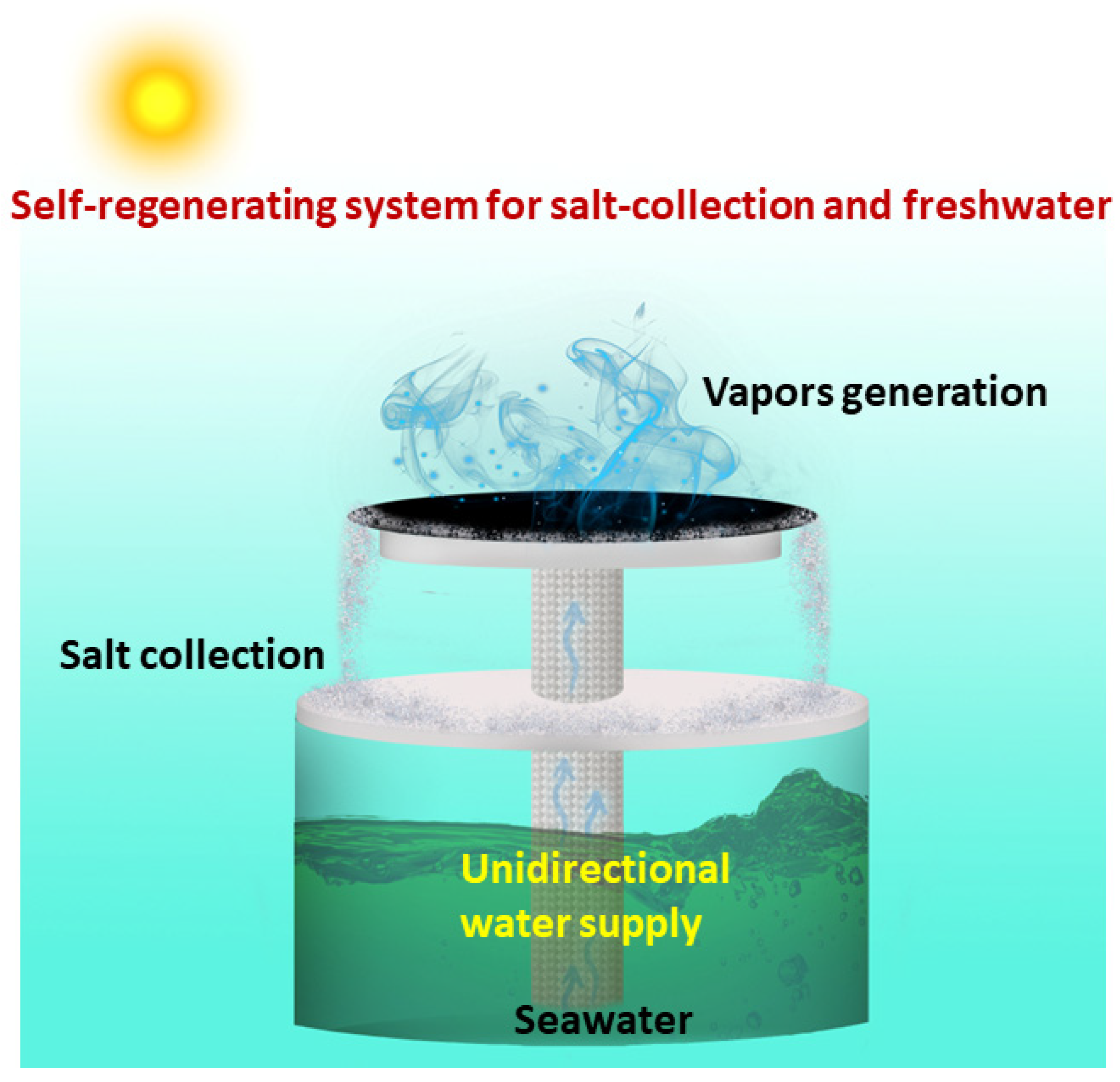
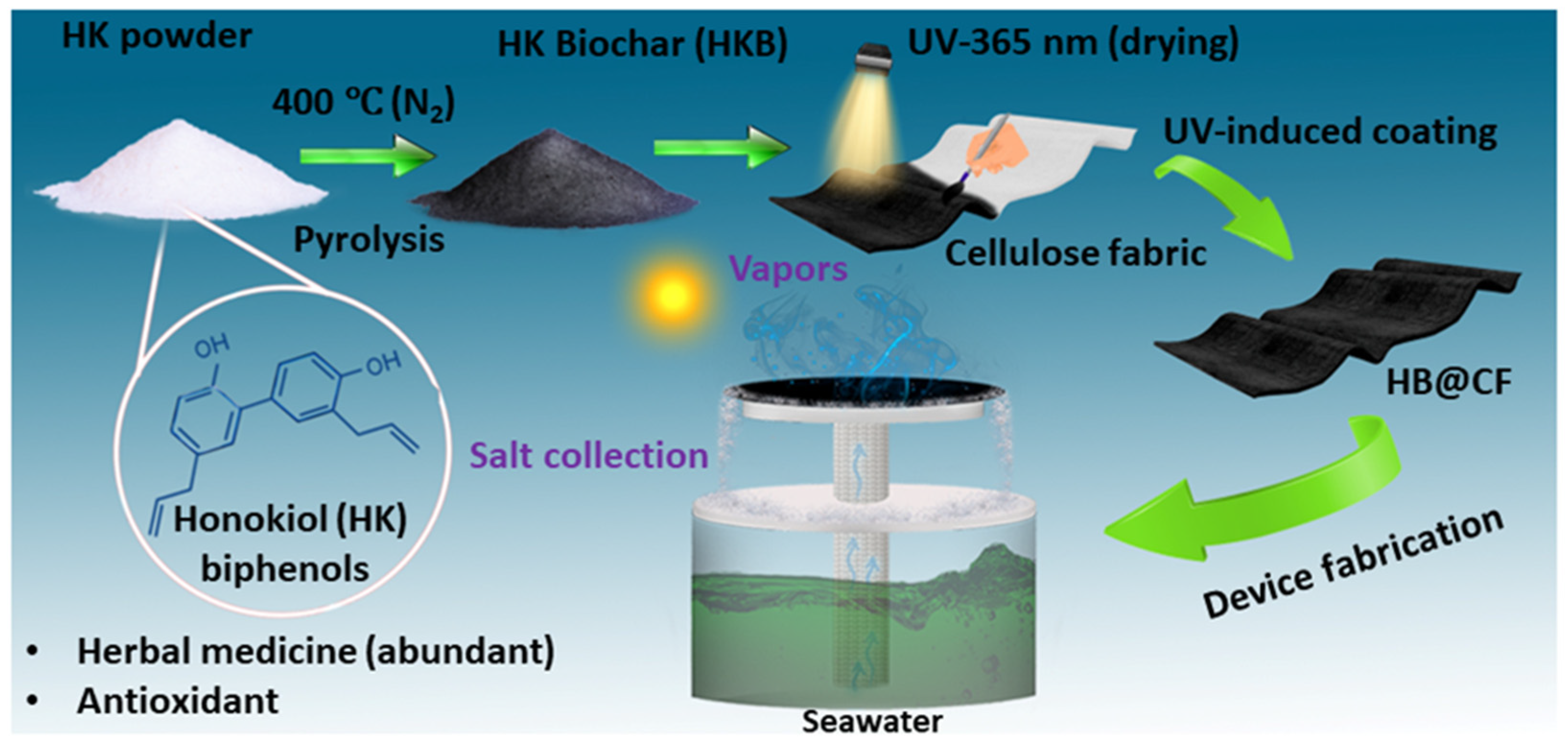

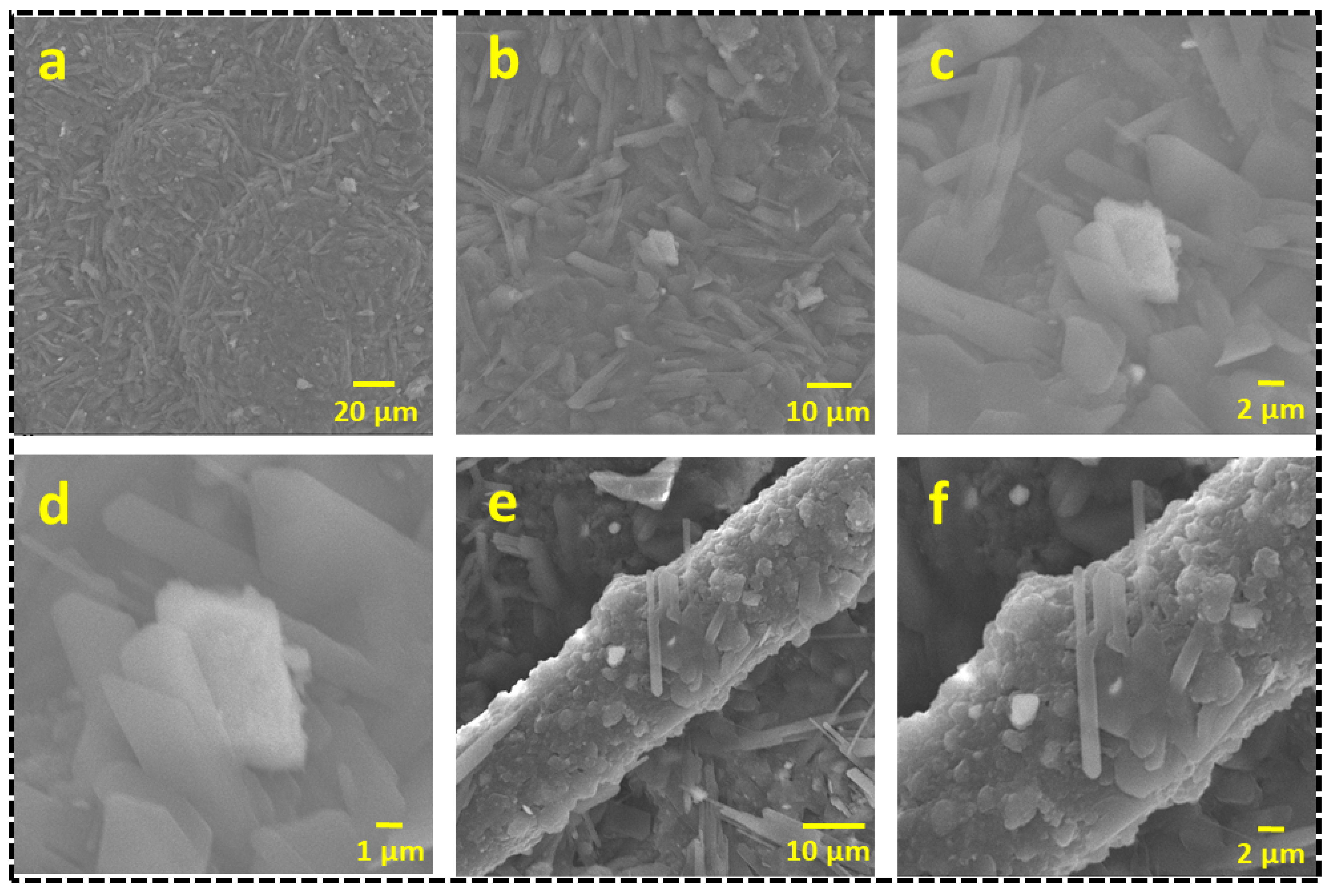

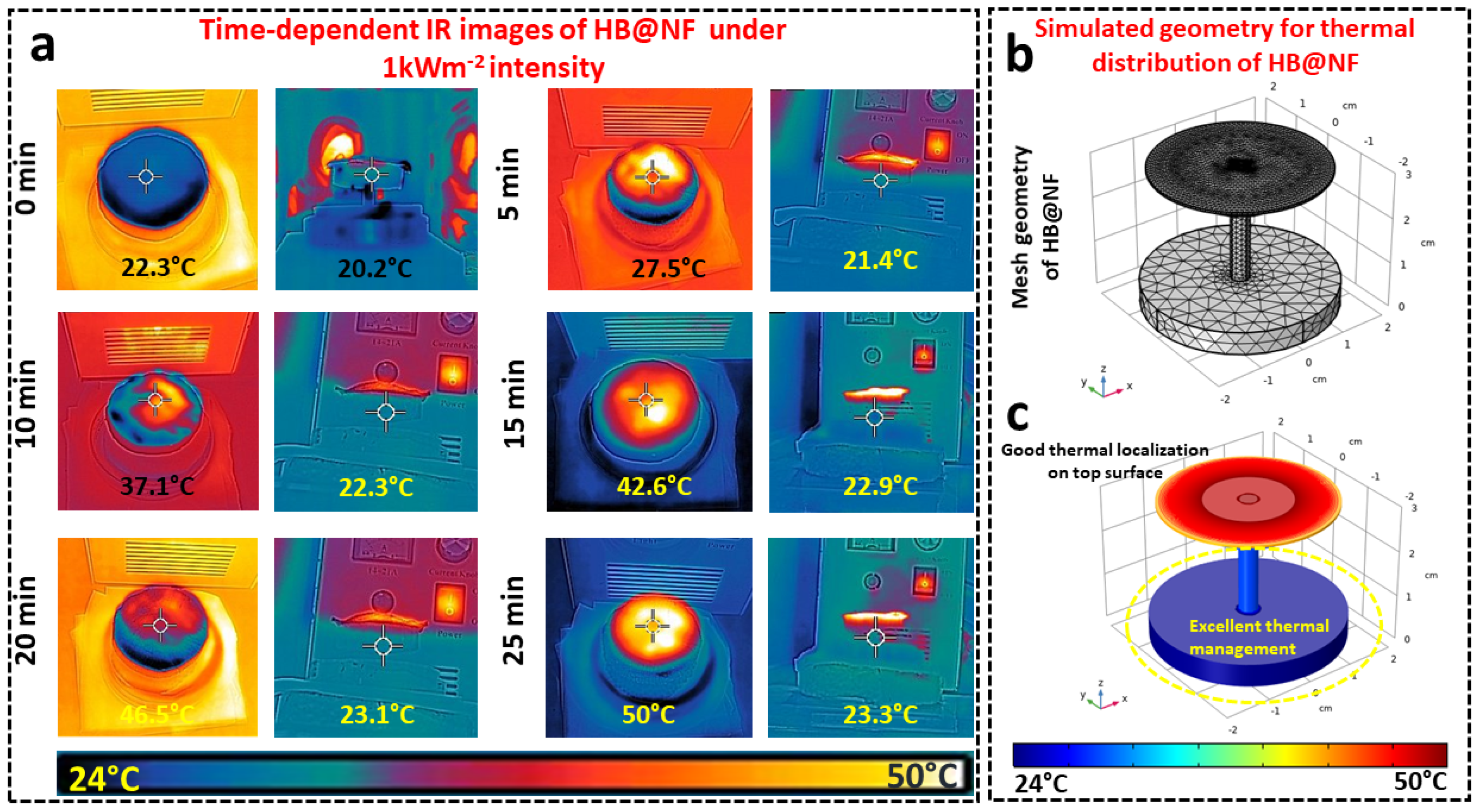
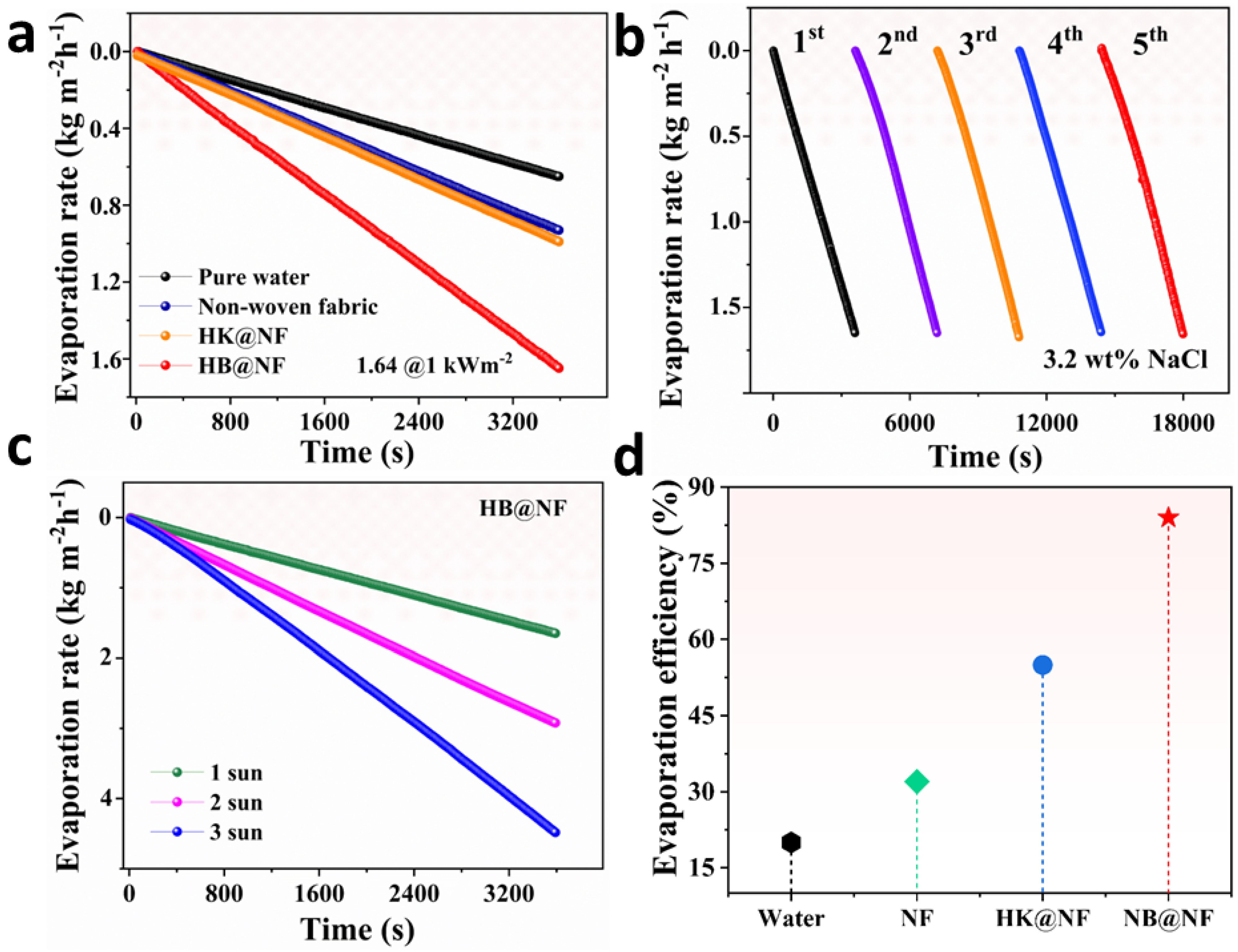

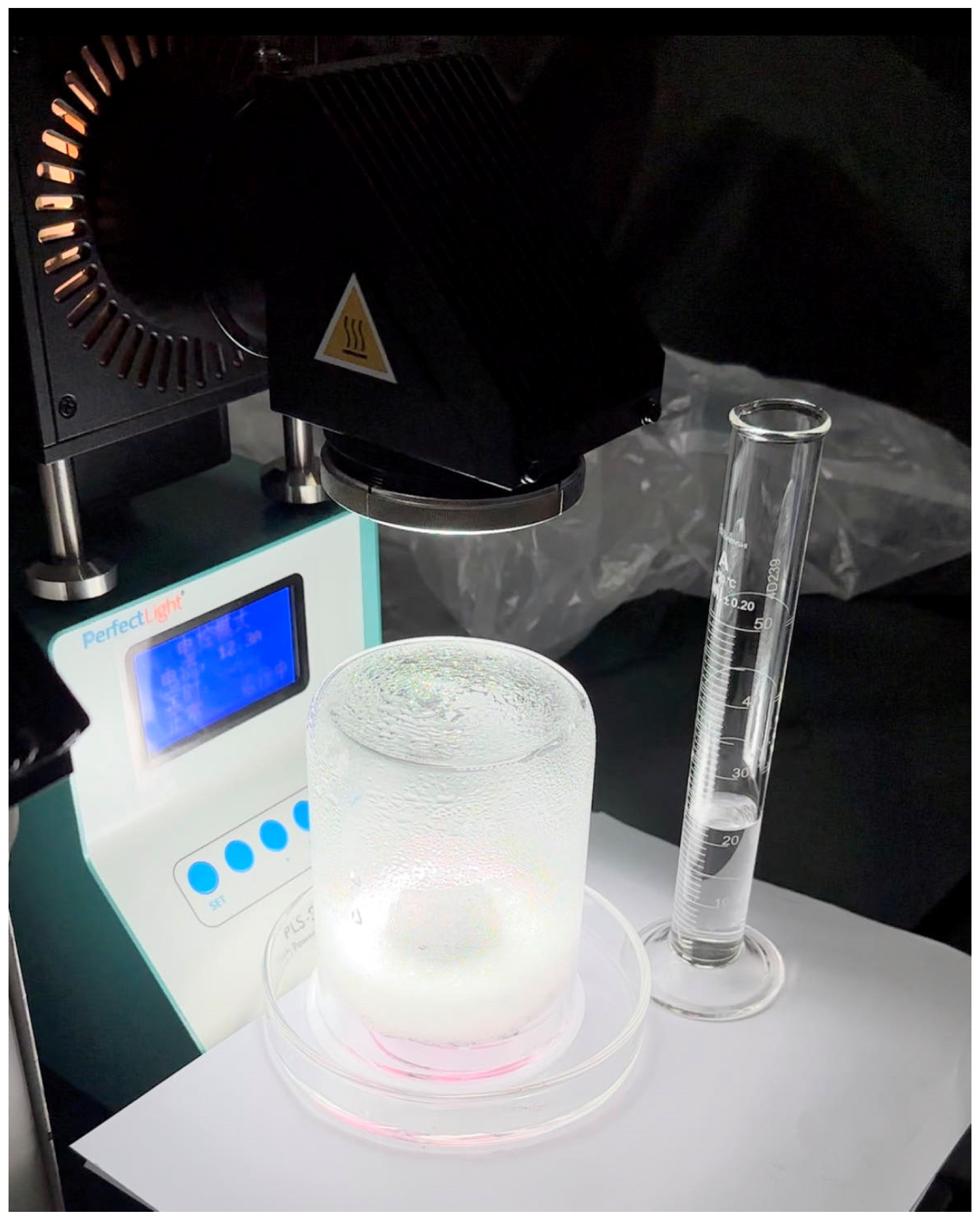
Disclaimer/Publisher’s Note: The statements, opinions and data contained in all publications are solely those of the individual author(s) and contributor(s) and not of MDPI and/or the editor(s). MDPI and/or the editor(s) disclaim responsibility for any injury to people or property resulting from any ideas, methods, instructions or products referred to in the content. |
© 2023 by the authors. Licensee MDPI, Basel, Switzerland. This article is an open access article distributed under the terms and conditions of the Creative Commons Attribution (CC BY) license (https://creativecommons.org/licenses/by/4.0/).
Share and Cite
Alomar, M.; Almutairi, B.S.; Alterary, S.S.; Awad, M.A.; Hussain, F.; Hendi, A.A.; El-Tohamy, M.F.; Al-Hoshani, N. Self-Regenerating Solar Evaporation System for Simultaneous Salt Collection and Freshwater from Seawater. Water 2023, 15, 3697. https://doi.org/10.3390/w15203697
Alomar M, Almutairi BS, Alterary SS, Awad MA, Hussain F, Hendi AA, El-Tohamy MF, Al-Hoshani N. Self-Regenerating Solar Evaporation System for Simultaneous Salt Collection and Freshwater from Seawater. Water. 2023; 15(20):3697. https://doi.org/10.3390/w15203697
Chicago/Turabian StyleAlomar, Muneerah, Badriah S. Almutairi, Seham S. Alterary, Manal A. Awad, Fida Hussain, Awatif A. Hendi, Maha F. El-Tohamy, and N. Al-Hoshani. 2023. "Self-Regenerating Solar Evaporation System for Simultaneous Salt Collection and Freshwater from Seawater" Water 15, no. 20: 3697. https://doi.org/10.3390/w15203697







